Although most of the findings in our TV reviews can be extrapolated to other models within the same range given identical specifications, occasionally there exist subtle discrepancies between different screen sizes. For example, we found the 32-inch Sony W6 LED television we tested last month to have a higher (albeit not detrimental) input lag than the 42-inch version. It is with this in mind that we got the Sony KDL46W905 into our test room, even though we’ve already reviewed its larger, 55in sibling back in May.
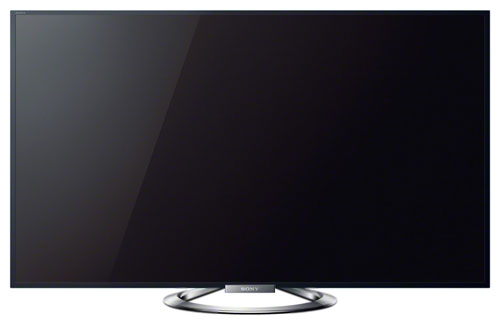
The KDL-46W905A is the 46-inch model within Sony’s W9 series of flagship 1080p Bravia LED LCD TVs. It features edge LED backlight with pseudo-local dimming, Triluminos Display quantum dot technology, X-Reality PRO image processing engine, MotionFlow XR 800Hz motion, active 3D, inbuilt Freeview HD and a satellite tuner, integrated wireless connectivity, one-touch NFC remote mirroring, as well as the Japanese manufacturer’s Smart TV platform. Will it deliver similar picture performance to the 55-inch KDL-55W905A, or are we in for a surprise? There’s only one way to find out.
Note: The specific model we reviewed was the Sony KDL46W905ABU, the 3-pin-plug UK version which is sold by British web merchants such as Amazon, or high street retailers like Currys and John Lewis. Its styling, user menu, rear connections and remote controls are the same as those found on the larger KDL55W905, so please refer to that review if you need more details or a refresher.
As always, we used a Klein K10-A reference-grade meter together with CalMAN 5, the industry-leading video calibration software to capture the luminance and colour output from the KDL46W905, with the intention of bringing them to spec if they’re originally not.
Now that we’ve seen Sony’s entire 2013 full HD 1080p lineup of Bravia flat-screen televisions, we automatically switched [Scene Select] to “Cinema“, knowing that this is the most accurate picture preset out of the box without getting into more advanced calibration. Here’s how it measured on our review sample.
With [Colour Temperature] left at its default setting of “Warm 2” without touching any other options, the Sony KDL46W905A produced a greyscale whose red component got progressively stronger as the picture got brighter. That said, delta errors (dEs) exceeded the visible threshold of 3 only from 70% stimulus and above, meaning that only the brighter portions of the image displayed a slight red tint. This represents a very good out-of-the-box greyscale performance.
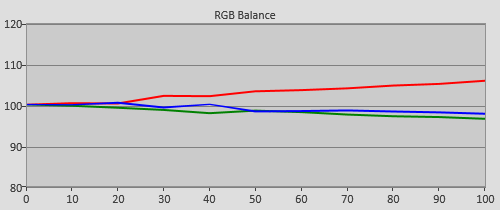 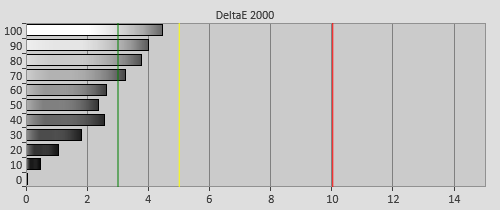 |
| Pre-calibration RGB tracking and delta errors (dEs) |
Of course, given our penchant for accurate images throughout the entire luminance range, we set about dialling out the red cast however mild. A few clicks to the [R-Gain] and [B-Gain] controls in the [White Balance] submenu was all that’s required to bring greyscale in line with D65.
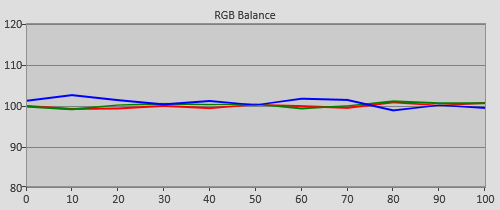 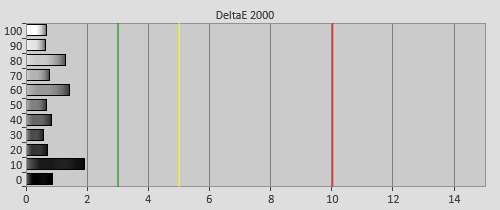 |
| Post-calibration RGB tracking and delta errors (dEs) |
dEs dropped to below 2 from 0% to 100% stimulus, which is an excellent result, delivering neutrally-tinted pictures.
We’ve praised Sony for embracing 2.4 gamma – a value that has been recommended by no less an authority than the ITU (International Telecommunications Union) as the reference EOTF (electro-optical transfer function) for HDTV displays used for dark-room studio mastering – on its 2013 Bravia LED TVs, and the 46in W905 continues this fine trend.
![Pre-calibrated Gamma tracking in [Cinema 1] mode](https://www.hdtvtest.co.uk/news/wp-content/uploads/2018/04/hdtv_Sony-KDL46W905_pre-gamma.png) | ![Post-calibrated Gamma tracking in [Cinema 1] mode](https://www.hdtvtest.co.uk/news/wp-content/uploads/2018/04/hdtv_Sony-KDL46W905_post-gamma.png) |
| Pre-calibration gamma tracking (2.37) | Post-calibration gamma tracking (2.36) |
Gamma tracked very closely to 2.4 even before calibration, contributing to a contrast-rich image together with realistic-looking rise out of black.
Every year, we point out the absence of an advanced colour management system (CMS) on Sony HDTVs despite all other major TV brands offering one, but the Japanese company has continued to ignore our plea. Thankfully, there’s nothing awry with the colours in the [Cinema 1] preset, as long as [Live Colour] was left off. Once greyscale was calibrated, and [Colour] was bumped up to “52“, we obtained a highly accurate colour performance.
![Post-calibration colour saturation tracking in [Cinema 1] mode](https://www.hdtvtest.co.uk/news/wp-content/uploads/2018/04/hdtv_Sony-KDL46W905_post-strack.jpg) |
| Post-calibration colour saturation tracking |
![Post-calibration colour errors in [Cinema 1] mode](https://www.hdtvtest.co.uk/news/wp-content/uploads/2018/04/hdtv_Sony-KDL46W905_post-strack-de.png) |
| Post-calibration colour errors (<3 not appreciable to the eye) |
Delta errors were reduced to below 3 for all six primary and secondary colours, and across all the measured saturating tracking points. A stunning result, especially when you consider there’s no onboard CMS.
| Dead pixels | None |
| Screen uniformity | Very good for an edge LED TV |
| Overscanning on HDMI | 0% if [Screen Format] “Full” & [Display Area] “Full Pixel“ |
| Blacker than black | Passed |
| Calibrated black level (black screen) | LEDs dim down/ shut off |
| Calibrated black level (ANSI checkerboard) | 0.041 cd/m2 |
| Black level retention | Auto-dimming with full black screen |
| Primary chromaticity | Slightly undersaturated green |
| Scaling | Very good |
| Video mode deinterlacing | Decent |
| Film mode deinterlacing | Passed 3:2 cadence over 480i |
| Viewing angle | Acceptable for VA LCD panel |
| Motion resolution | 1080 (but double image) with [Motionflow] “Impulse“; 300, off |
| Digital noise reduction | Optional; effective when engaged |
| Sharpness | Defeatable edge enhancement |
| Luma/Chroma bandwidth (2D Blu-ray) | Full luma; chroma horizontally blurred except in [Game] & [Graphics] modes |
| 1080p/24 capability | Judder-free in 2D and 3D |
| Input lag (high-speed camera) | 8ms in [Game] mode |
| Leo Bodnar input lag tester | 20ms in [Game] mode |
| Full 4:4:4 reproduction (PC) | Yes, in [Game] and [Graphics] modes |
| Default [Standard] mode | 31 watts* |
| Calibrated [Cinema 1] mode | 57 watts |
| Standby | <1 watt |
*Note: Out of the box, [Light Sensor] is engaged by default, which explains why energy usage was lower before calibration than after.
Natively, the Sony KDL46W905 exhibited a slightly deeper shade of blacks than its bigger 55-inch brother, coming in at 0.041 cd/m2 on a 4×4 ANSI checkerboard pattern after we pegged peak white to our usual target of 120 cd/m2. Of course, like most edge-lit LED televisions these days, the 46W9 partakes in some auto-dimming when asked to display a full black screen: if [LED Dynamic Control] was switched off, the black level would drop to 0.021 cd/m2. Defeating the auto-dimming by displaying a small number of lit pixels on screen (for example by a pause icon from our Blu-ray player) would raise the black level marginally to 0.028 cd/m2.
Sony’s pseudo-local-dimming algorithm on its Bravia edge LED TVs is arguably the most well-implemented on the market, contributing to improved contrast while avoiding the normal pitfalls of haloing and crushed shadow detail. On the KDL-46W905A, this comes in two strengths: [LED Dynamic Control] “Low” or “Standard“. The former yielded blacks of 0.0347 cd/m2 ANSI, and 0.0078 cd/m2 on a full-field video black screen with auto-dimming defeated; whereas the corresponding figures for the latter were 0.0346 cd/m2 and 0.0049 cd/m2. Both settings caused the LEDs to totally shut off when fed with a full-field black signal.
Between these two settings, we preferred “Low“, since the more aggressive dimming algorithm of “Standard” resulted in noticeable halos during certain scenes. Both improved black level to a similar degree as far as ANSI contrast measurements are concerned, so there’s no good reason to opt for “Standard” over “Low“.
Once calibrated, our review unit evinced very good backlight uniformity, with nary a hint of bleeding from the corners or clouding even when inspected in a dimly-lit environment. Due to the way LED bulbs that are arranged along the borders of the LCD panel have to illuminate the entire screen, some DSE (dirty screen effect) inevitably creeped in especially during panning shots across a uniformly-toned background (such as a football field), but it never really bothered us in real-world viewing.
Without any assistance from motion enhancement technologies, the baseline motion resolution on the Sony KDL46W905A (as determined through the horizontally scrolling lines pattern in Chapter 31 of the FPD Benchmark Software disc) was – say it together now – 300.
The Japanese manufacturer offers three ways of improving motion clarity on its W905A series: motion-compensated frame interpolation (MCFI), black frame insertion (BFI), or a combination of both – all selectable through the [Motionflow] control. “Standard” and “Smooth” are MCFI-based, which introduces soap opera effect and some interpolation artefacts, so we really don’t recommend using them.
BFI can be engaged by setting [Motionflow] to “Impulse“, which inserts additional black frames inbetween the original frames to “reset” our retinal persistence, leading to perceptibly clearer motion. While useful, it comes with a few downsides that are pretty much unavoidable due to how the technology works. Light output dipped significantly with [Motionflow] “Impulse“: we managed to extract 97 cd/m2 from the set even with [Backlight] and [Contrast] bumped up to maximum, which makes it suitable probably only for rooms with low ambient light. Also, you may notice flicker or double-image ghosting with certain material, though we did not encounter many instances in photorealistic content.
“Clear” and “Clear Plus” are MCFI plus a degree of black frame insertion, with the latter being dimmer. From our testing, both did not introduce any significant interpolation artefacts or soap opera effect – “Clear” is the better choice due to its higher light output.
What can we say, HD material looked utterly gorgeous on the KDL46W905, thanks to accurate greyscale and colours which lent a seldom-seen degree of authenticity to tricky-to-render shades like flesh tones and foliage. Black level, which was already very good by LED LCD standards, could be made deeper without noticeable compromise in shadow detail by engaging [LED Dynamic Control]. Together with 2.4 gamma (Sony has to be commended here for embracing this standard), the impressive blacks imparted a gratifyingly rich, high-contrast look to every type of content we threw at the 46″ Bravia W9.
We complained about the limited viewing angle on the 55″ version of the W905, but we saw no such issue on this 46-incher: its off-axis performance was about as good as we’ve seen from a VA-based LCD panel, i.e. roughly on par with Samsung’s F8000 range. Whether this improvement is down to different screen sizes or the individual sets is anyone’s guess.
The Sony KDL-46W905A’s upscaling quality belonged in the upper tier among its peers, capturing all the standard-def resolution then displaying it crisply with only minor ringing. Video-mode deinterlacing was decent rather than stellar, betraying more jaggies than competing models from major HDTV brands, though we’d be lying if we said we saw many in real-life viewing. The 46W9 correctly detected and processed 3:2 cadence over 480i, but failed for the more important (at least in the UK) 2:2 film-mode deinterlacing – we suggest sending progressive video signal to the LED TV to avoid seeing twitter, jagged edges or resolution loss in film-based material.
This year’s Sony Bravias have been a hit among hardcore gamers owing to their class-leading gaming responsiveness, and the KDL46W905 is another fine example. With [Scene Select] set to “Game“, we measured the television’s input lag at 8ms using the traditional stopwatch/ high-speed camera method, and 20ms via the Leo Bodnar tester. The latter device also returned a figure of 29ms once [Motionflow] “Impulse” was enabled, and an eye-watering 105ms in other non-Game modes.
The Sony KDL46W905A is the best 46in flat-screen TV we’ve tested this year in terms of 2D picture quality. Compared to its larger 55-inch W9 sibling, the viewing angles were wider, and blacks went a bit deeper, though how much of these improvements was the result of individual variation remains unknown. And the killer feature on this LED television is surely its ultra-low input lag, making it the ideal companion for next-generation consoles like the Sony PlayStation 4 (PS4).
